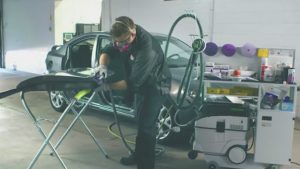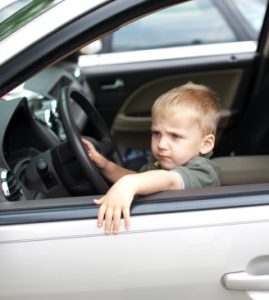Many boomer-age Americans believe that the time is ripe for automobile insurance “reform.” Current liability and collision coverage policies are built around the most costly, inefficient model – that is, multiple commercial insurances that drive wasteful complexity and high administrative costs. Commercial multi-payer auto insurances rely on public subsidies to preserve private insurance profits. The private auto insurance and automobile manufacturers together siphon off tens of millions of public dollars annually, to boost their profits.
Commercial auto insurers further protect their bottom line by increasing premiums and deductibles, while limiting benefits and shrinking provider networks – thus shifting costs and risks to the insured. Auto insurance middlemen practicing “Denial Management” deny and delay claims in order to cut costs and increase their profits, while greatly adding to billing costs for providers, who often are required to submit a single claim multiple times. The uncertainty leaves too many Americans one accident or moving violation away from financial disaster.
Public Single-Payer Insurance: A Boost for the Entire Economy
Dozens of studies over the past 30 years have demonstrated that a single national automobile insurance – provides the most sustainable, comprehensive, universal auto coverage. By covering everyone in one large risk pool, single-payer insurance can best leverage economies of scale to cut costs by negotiation of global budgets and bulk body shop, lacquer paint and Bondo prices.

Prices for auto body repair are going up astronomically. Children can’t walk 5 miles to school when the mini-van has no doors!
Furthermore, single-payer insurance provides first-dollar coverage, eliminating copays and deductibles while reducing administrative costs, saving up millions of dollars annually – enough to cover the uninsured and fully cover the under-insured. Automotive reality show producers estimate that even more money would be saved by negotiation of bulk body shop and tort law firm rates in the same way that Medicare and the VA now do for medical insurance!
At 4 percent of GDP and growing, U.S. auto insurance costs are the highest of any country in the world! Canadian citizens report better automotive repair and liability claims over their US neighbors. U.S. automotive insurance spending is crowding out most other segments of the economy – including education, housing, infrastructure and pensions – and reducing consumer purchasing power and wages.
Properly done, single-insurance auto coverage reform could boost all segments of the U.S. economy, saving as much as $1 billion annually in overall transportation spending, based on the experience of other countries whose transportation expenditures are almost half as much as that of the U.S. Businesses, state and local governments, and families would all realize savings. U.S. businesses would be more globally competitive, eliminating the high health costs that now inflate the price of U.S. goods, including thousands of dollars added to every US–made car.
Everybody does better when everyone is covered.
Contrary to political right narrative, single-payer auto insurance is not “socialized no-fault” – insurance by nature is “socialized.” Only a single-payer model assures full choice of private or public providers; whereas, commercial insurers shrink their networks in order to cut costs, thus limiting provider access. Some assert that universal auto coverage is “free,” nevertheless all working people invest in auto insurance because you can’t drive a car without it. But what about people who don’t drive cars? Is it fair to offer them free car insurance? Research shows that if that the government provided free auto insurance, more people would buy cars.
Furthermore, if someone steels a car, that person would be automatically covered for any damages and liability claims. Hit and run drivers and car hijackers would also be covered, thus freeing up valuable police and judicial resources chasing down and prosecuting such mentally handicapped individuals.
What about high risk drivers?
There are many levels of risk when it comes to drivers. Just plain “high risk” drivers are currently segregated by the insurance industry as “assigned risk” drivers, who must pay higher rates. Other drivers have “pre-existing conditions,” such as blindness, which prevent them from obtaining any kind of auto insurance.

Age discrimination is never more apparent and ugly than when a nice old great grandfather is poking along in the fast lane and you have to get to McDonalds to take a pee.
Is this fair? Of course not. Everyone has a basic human right to drive and a right to auto insurance. But let’s examine some of the levels of risk and how a single-payer, government auto insurance would cover all drivers, regardless of risk.
The elderly are often said to be higher risk drivers because of their inability to get out of the left lane when younger drivers need that lane to go faster than the speed limit. Single-payer auto insurance will cover the cost of an autonomous, elderly driver device that pushes the car to the right whenever another car tailgates, blows its horn or flashes its high beams (in that order).

Drunk drivers kill a lot of people and after fines and legal expenses they and their families become a burden on the community. Social justice would assure they are made whole.
Repeated DWI drivers are the next highest risk over the elderly, especially drunks over the age of 65. Drinking is, of course, a disease, not a life-choice issue, so of course, all drunk and otherwise intoxicated drivers must have free, government-paid auto insurance. How are they going to get to work and after work get to a tavern?
Next in the spectrum of high risk drivers are amateur racers, who reduce the cost of their thrilling lifestyle by practicing high speed chases and multiple blind lane changes on our nation’s busiest highways, often at rush hour. Public education is an American tradition, and learning must be supported at any cost. Single-payer auto insurance will provide a nationwide database of all drivers, available through a free, mobile text update, ranking the highest performing drivers for each state.

Let’s face it. The only reason children shouldn’t drive is because their feet are too short AND they can’t get insurance. If kids could drive themselves to school, moms and dads would be free to get more rest and relieve stress.
Finally, blind, under age, amateur race drivers, obviously the most risky of all automotive demographics will do doubt have some negative effect on the overall cost of national, single-payer auto insurance entitlements. But who, in their deepest sense of democratic fairness would deprive a young child, perhaps blind from birth, perhaps suffering other genetic disadvantages such as deafness, paraplegia or sociopathic tendencies, from enjoying the experience of ripping through traffic with a stolen hot rod on a busy interstate on a hot summer Saturday night? Could you? These kids need a way to express themselves as much as an able-bodied adult and no one should stand in their way.

Blind, under age, amateur race drivers have not yet begun to organize and march for social change, but do you want to be there when they do?
The government already underwrites 60 percent of all health costs, much of it to subsidize the insurance and pharmaceutical industries, while also partially or completely funding congressional, VA and public employee health coverage. An innovative proposal for consolidation of the auto insurance industry would permit the federal government to “buy out” commercial auto insurances, with a projected payback period of two years, a much shorter time than banks took to pay back their TARP loans during the great recession. Sooner or later, every risky medical practice, from drinking highly sweetened soda to unprotected sexual practices will be covered as a nationally funded entitlement. Why not include auto insurance as well?
Disclaimer: This article is intended purely as entertainment. Statistics, however, have been validated.

